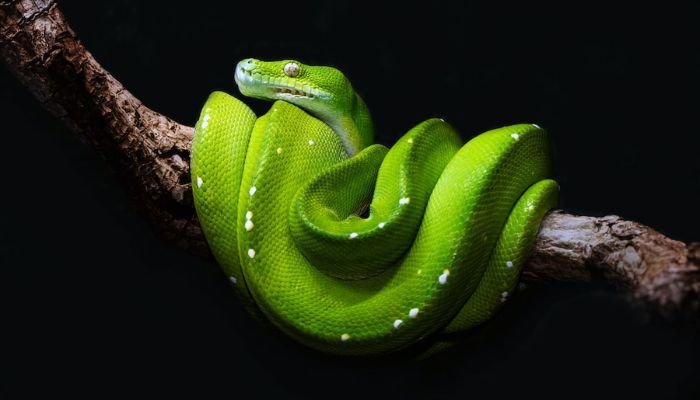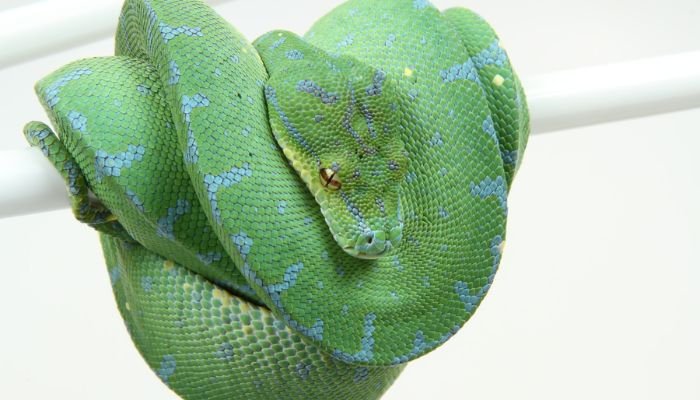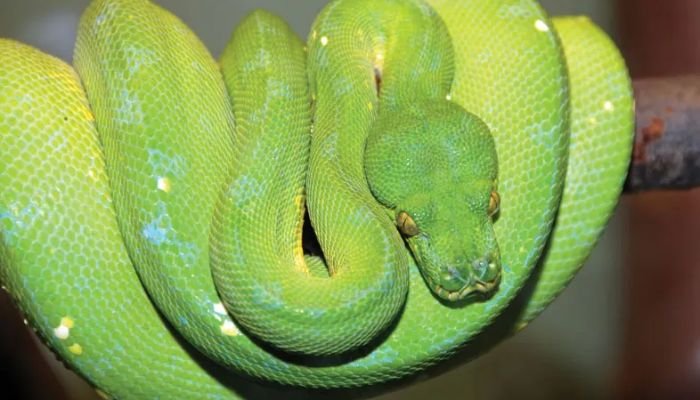
The breathtakingly beautiful Green-tree python inhabits the rainforests of New Guinea, Indonesia, and Australia. Its vibrant green color and ability to wind itself around tree branches have earned it this name. Green tree pythons must suffocate their prey, which consists primarily of small mammals and birds, in order to subdue it. They are well-known for their unique propensity of sleeping in coiled positions on tree branches while blending in with the foliage.. Here are Green-tree python Guide on Food, Habitat, Size, Lifespan & Predators below-
Green tree python Stats in Table format
The stats are given below for Green tree python
| Reptiles List | Green tree python |
|---|---|
| Family | Pythonidae |
| Type | Snake |
| Size | Medium to Large |
| Length | Green tree python: Up to 4-6 feet (1.2-1.8 meters) |
| Color | Green tree python: Can have various colors, but green tree pythons usually have a green or greenish-blue coloration. |
| Weight | Green tree python: Adult green tree pythons can weigh between 1 to 2 pounds.. |
| Lifespan | 15-20 years (or more) |
| Reproduction | Oviparous, lays eggs |
| Gestation Periods | Approximately 6-7 months |
| Endangered Status | Least Concern (IUCN Red List) |
| Features | Vibrant green coloration, coiled posture |
| Country & Areas | Australia, Indonesia, Papua New Guinea, and the Solomon Islands. |
Green Tree Python Natural Habitat and Distribution
The Green Tree Python is endemic to the tropical forests of New Guinea, Indonesia, and Australia’s Cape York Peninsula. The abundance of trees, shrubs, and other plant life in these areas makes them ideal for the species’ survival. Green-Tree Pythons are mostly arboreal, meaning they spend most of their time in the tree canopy. Due to the effectiveness of their hunting techniques, camouflage, and protection measures, they prefer to make their homes in the treetops.
Green Tree Python Physical Features and Adaptations
Here are some information on Green Tree Python Physical Features and Adaptations:-
Body Structure
Adult Green Tree Pythons typically reach lengths of 4 to 6 feet, making them one of the shortest python species. Their slim build and prehensile tail make them adept at life under the canopy. Their triangular, slightly enlarged heads have pits that are sensitive to heat and help them locate warm-blooded food.
Coloration and Patterns
The Green Tree Python’s vivid coloring is one of its most distinctive characteristics. Different colors of green, from lime to emerald to turquoise, are available. This vivid coloring serves both as cover and an ambush point while hunting, making it an advantageous trait.
Defense Mechanisms
When they are threatened, Green Tree Pythons will take on a number of protective stances. Flattening their body, baring their sharp fangs, and hissing loudly are all possible behaviors. Their lovely iridescent scales may sometimes be intimidating because of their ability to reflect light.

Green Tree Python Diet and Feeding Habits
Here are some information on Green Tree Python Diet and Feeding Habits:-
Diet Type
Green Tree Pythons are strict carnivores, meaning that they only eat meat. As constrictors, they sneak up on their prey, launch a surprise attack, and then encircle and choke the victim before swallowing it whole.
Preferred Food Sources
Microscopic animals and birds make up the bulk of a Green Tree Python’s diet. They are patient predators who wait for their prey in ambush for long periods of time.
Feeding Schedule
Pythons of varying ages and sizes require feedings at varying intervals. Adult snakes can go 10-14 days between feedings, but younger snakes may need food more frequently (every 5-7 days). Pre-killed or thawed frozen prey should be offered at all times to prevent injuring the snake, and feedings should take place inside the enclosure.
Green Tree Python Housing and Enclosure Requirements
Here are some information on Green Tree Python Housing and Enclosure Requirements:-
Terrarium Size and Setup
A Green Tree Python requires a terrarium that is set up vertically. The minimum dimensions for an adult enclosure are 4 feet in height, 2 feet in width, and 2 feet in depth. This arrangement mimics their native environment by providing plenty of places to climb.
Substrate Options
Coconut husk, cypress mulch, or orchid bark are all good options for substrates since they promote stable humidity levels and allow for normal burrowing activities.
Temperature and Lighting
Green Tree Pythons do best in daytime temperatures between 78 and 85 degrees Fahrenheit (25 and 29 degrees Celsius), with a little dip at night. Ceramic heat emitters or under-tank heating pads can provide sufficient heat. They also need to be exposed to full-spectrum UVB lighting.
Humidity and Water Needs
These pythons need a constant humidity of between 60 and 80 percent. A huge water dish will do double duty as a humidifier and a place for the snake to drink.

Green Tree Python Behaviour and Temperament
Here are some information on Green Tree Python Behaviour and Temperament:-
Activity Levels
During the night is when Green Tree Pythons are most active and hence when they hunt for food. They spend the day napping and conserving energy by curling up in a safe place.
Social Behaviour
Despite their solitary nature, Green Tree Pythons have been observed engaging in territorial behavior. During the mating season, males can be hostile toward one another, but otherwise, this snake prefers to keep to itself.
Handling and Taming
Careful handling is required if interacting with a Green Tree Python; taming is not recommended. Normally non-aggressive toward people, they can grow agitated when handled too much. The taming process should be taken carefully and softly to prevent the snake from experiencing any undue stress.
Green Tree Python Breeding and Reproduction
Here are some information on Green Tree Python:-
Mating and Courtship Rituals
The mating ritual of the Green Tree Python is unlike any other snake species. The male woos the female with undulating, rhythmic movements that highlight his vivid coloring during courtship. After a successful mating, the female will lay her eggs.
Incubation and Hatchlings
The females of these species lay their eggs in concealed places like tree cavities or rock cracks. After she’s done depositing her eggs, the female doesn’t stick around to care for them. Snake hatchlings, measuring between 12 and 18 inches in length, emerge from their eggs after 45 to 60 days.
Green Tree Python Common Health Issues and Veterinary Care
Here are some information on Green Tree Python Common Health Issues and Veterinary Care:-
Respiratory Infections
Inadequate husbandry, such as too-low temperatures or too-high humidity, can lead to respiratory diseases. Wheezing, breathing with the mouth open, and a mucusy mouth are all indicators of respiratory distress. Seek emergency veterinarian attention if any of these signs are noticed.
Parasites:
Parasites, both internal and external, are a risk for Green Tree Pythons just as they are for other reptiles. In order to keep an eye on and cure any parasite infections, a reptile’s feces must be examined regularly by a vet.
Metabolic Bone Disease
MBD, or metabolic bone disease, can develop when the body does not get enough calcium and vitamin D. Snakes with MBD often have weakening bones, physical abnormalities, and a shortened lifespan. A healthy diet and exposure to UVB light are crucial in warding against this illness.

Importance of Regular Vet Check-ups
If you care about your Green Tree Python’s health and well-being, you should take it in for checkups at the vet on a regular basis. Veterinarians that specialize in caring for reptiles can spot and treat health problems, advise on proper diet and housing, and prevent unnecessary suffering. Any health issue, if caught early enough, has a much better chance of being treated successfully and prolonging the patient’s life.
Conclusion
The Green Tree Python is a remarkable reptile because of its eye-catching appearance, remarkable adaptations, and fascinating habits. The commitment to providing the correct environment, nourishment, and treatment is necessary if you want to keep these snakes as pets, as fascinating as they are.
Reptile lovers can have the rewarding experience of caring for these wonderful creatures in captivity by learning about and adhering to their specific environmental and biological requirements. Keep in mind that maintaining the health and lifespan of these intriguing residents of the rainforest requires routine visits to the veterinarian.
FAQs
Q: What is the family and Type of Green tree python?
A: The Green tree python is a species of family Pythonidae. The Famous Green tree python is a member of the family Snake.
Q: What is the average size of a Green tree python?
A: The average adult Green tree python is Medium to Large between Green tree python: Up to 4-6 feet (1.2-1.8 meters).
Q: How long can a Green tree python grow in size in lengths?
A: Green tree python is Medium to Large in size and The green tree python can grow to be approximately 4-6 feet in length, which is equivalent to 1.2-1.8 meters.
Q: What colors do Green tree pythons come in?
A: The green tree python is a fascinating reptile that comes in a variety of colors. However, the most common coloration for this species is a vibrant green or a beautiful greenish-blue shade..
Q: How big can a Green tree python get in weight?
A: The adult green tree python is known to have a weight range of 1 to 2 pounds.
Q: What are the special Features of a Green tree python?
A: Green tree pythons with are Vibrant green coloration, a coiled posture
Q: How long do Green tree pythons live?
A: The usual lifespan of a Green tree python is typically around 15 to 20 years, although some individuals may live even longer.
Q: What food does the Green tree python eat?
The virtuous tree Prey items for a python include small mammals, birds, and other reptiles. It primarily consumes small rodents like mice and rats, but also eats birds and lizards. From high in a tree, they can use their formidable fangs to capture and hold prey. Even bats and other small animals that make their homes in the trees are fair game for these birds.
Q: What is the best habitat for a Green tree python?
Like other snakes, green tree pythons prefer the warm, humid environment of a tropical rainforest. The steamy, humid jungles of New Guinea, Indonesia, and Australia were the first places where these snakes were spotted. Their cage needs to be tall and spacious, with lots of climbing branches and foliage to mimic their natural habitat. The enclosure needs both a warm basking area and cooler spots to help the snake keep its temperature just right. For proper shedding, green tree pythons need a certain level of humidity. They also need places to hide and water to stay alive.
Q: How do a Green tree python give birth?
A: Green tree pythons are Oviparous, and lay eggs
Q: How long is the gestation period for a Green tree python?
A: The gestation period of a Green tree python is approximately Approximately 6-7 months
Q: What is the natural behavior of a Green tree python?
Most Green tree pythons are found in The green tree python is largely arboreal in its natural activity, meaning it prefers to spend its time in the treetops. The New Guinea, Indonesian, and Australian rainforests are home to this snake’s natural habitat. The bright green coloring of this species makes it easy to hide amongst other plants. Ambush predators like green tree pythons use their camouflage to sneak up on and pounce on their prey, which consists primarily of small mammals and birds. They can climb very well thanks to their prehensile tails, which they use to grab onto branches. They rest by coiling themselves around tree branches during the day, but come nighttime, they become more active and may even relocate to new hunting grounds.
Q: Is the Green tree python endangered?
A: The Green tree python is Least Concern (IUCN Red List).
Q: What are the prey of Green tree python?
The green tree python eats a wide variety of animals, including small mammals like mice and birds, as well as reptiles. These snakes have earned a fearsome reputation for their lethality due to their ability to cling to tree branches and launch surprise attacks with their keen jaws. Their powerful, clamping jaws are another weapon in their arsenal. The green tree python’s diet consists primarily on other arboreal animals that are common in the same types of rainforests.
Q: Do Green tree python have any Predators?
Reptiles like the green tree python Birds of prey like hawks and eagles, as well as larger snakes like pythons and boas, are among the green tree python’s natural enemies. Small carnivores and mammals like monkeys are two more possible predators. These animals are drawn to the green tree python’s bright coloring and may attack it when it is most defenseless, such as when it is molting or resting in a tree.
Q: How Fast Does Green tree python Move?
A: The green tree python can move at speeds of up to 10 miles per hour.
Q. What is Bite Force of Green tree python in PSI?
A. Bite Force in PSI is a measure of the pressure exerted by the jaws of an animal during biting.
Q: Can we keep Green tree python as pets?
Because of how docile they are, green tree pythons make great pets. Their vibrant green coloration is a big draw for reptile enthusiasts. However, with the proper care and habitat, they can flourish in captivity. Be sure you can provide the proper environment and diet for one of these animals before bringing it home.
Are Green Tree Pythons venomous?
Incorrect; Morelia viridis (Green-tree python) are not poisonous. They are constrictor snakes, however they don’t bite. They don’t use poison to kill their victim, but rather their superior strength and toothiness. Green Tree Pythons can be seen in the rainforests of New Guinea and some areas of Australia, where their vivid green colour stands out.
Are Green Tree Pythons good for pest control?
Predating on rodents and other small mammals and birds, green tree pythons help keep pest numbers under check. However, as pets, they shouldn’t be expected to perform the function of pest control. As pets, they should only be kept by someone who have knowledge with reptiles and can offer the specialized environment and nourishment that these creatures need.
Do Green Tree Pythons require a UVB light source?
There is no hard and fast rule about the necessity of UVB lighting for green tree pythons. They are primarily crepuscular, or active at night or at dawn and dusk when UVB levels are lower, in the wild. The pros and cons of giving UVB lighting for captive reptiles are currently being discussed. While some snake keepers believe it’s important to treat these predominantly nocturnal snakes with modest levels of UVB to simulate natural lighting conditions, others disagree. UVB illumination isn’t as important as providing the right temperature ranges, humidity levels, and a secure environment with places to hide and climb. Green Tree Pythons require special attention, so it’s better to ask a vet who specializes in treating reptiles or a seasoned keeper for advice.
I hope you like reading on Green-tree python FAQ Guide on Food, Habitat, Size, Lifespan and Predators.
